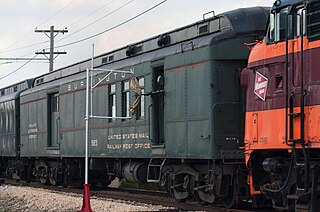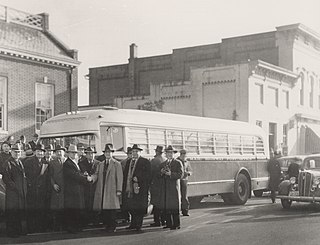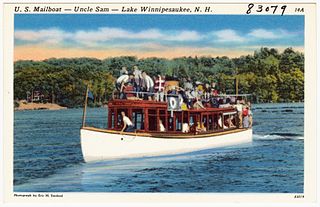The Railway Mail Service of the United States Post Office Department was a significant mail transportation service in the US from the mid-19th century until the mid-20th century. The RMS, or its successor the Postal Transportation Service (PTS), carried the vast majority of letters and packages mailed in the United States from the 1890s until the 1960s.

The United States Post Office Department was the predecessor of the United States Postal Service, established in 1792. From 1872 to 1971, it was officially in the form of a Cabinet department. It was headed by the postmaster general.

In Canada and the United States, a railway post office, commonly abbreviated as RPO, was a railroad car that was normally operated in passenger service and used specifically for staff to sort mail en route, in order to speed delivery. The RPO was staffed by highly trained Railway Mail Service postal clerks, and was off-limits to the passengers on the train.

Toronto Civic Railways (TCR) was a streetcar operator created and owned by the City of Toronto, Ontario, Canada, to serve newly annexed areas of the city that the private operator Toronto Railway Company refused to serve. When the Toronto Railway Company's franchise expired in 1921, its services were combined with those of the Toronto Civic Railways, and are now assumed by the new Toronto Transportation Commission (TTC). The first route of the TCR started operation on December 18, 1912.

Streetcars in Washington, D.C. transported people across the city and region from 1862 until 1962.
The Railway Mail Service (RMS) Library is a major collection of materials pertaining to en route distribution history. Incorporated in May 2003, it can assist researchers interested in Railway Mail Service, route agent, Seapost, Railway Post Office (RPO), and Highway Post Office (HPO) history. The collection has many unique, original-source documents that provide answers to questions dealing with the transportation and distribution of USA Mail between 1862 and 1977, as well as other countries during the 19th century and 20th century.

The term highway post office refers to brightly colored red, white and blue buses used to carry mail to multiple areas over wide distances.
An air mail facility is an installation for airmails of the United States.
Terminal railway post offices were sorting facilities which were established by the Railway Mail Service to speed the distribution of parcel post. These offices were usually located in or near railroad stations in major cities or junction points. Terminal railway post offices operated generally from 1913-1914 into the mid-1960s, before their function was absorbed by post office sectional centers.

From the 1880s until well into the 1950s, virtually all long-distance transportation of United States Mail was performed by the railroads. Specially equipped railway post office (RPO) cars were a part of most passenger trains, the cars staffed by highly trained railway postal clerks who sorted mail as the train sped along its route. The growth of this mail distribution network paralleled the expansion of the railroads, allowing mail to be exchanged between routes at junction points where two railroads crossed or shared passenger terminals.

Post was transported over water in the United States in the later nineteenth and the twentieth century.
The Postal Transportation Service (PTS) was the renamed successor to the Railway Mail Service of the United States Post Office Department from October 1, 1949. Although this branch of the service had been in charge of all transit mail, some parts had little to do with railroads, even though they were still the most important part of the service. In 1950, of the 32,000 clerks assigned to the PTS, only about 16,000 actually worked on trains. The remainder were in terminals, transfer offices, Air Mail Facility, Highway Post Offices (HPO), administrative offices, etc. Boat Railway Post Office, Streetcar Railway Post Offices, and the Seapost Service had already been discontinued. The name of the Chief Clerk's office was changed to District Superintendent's office.
The Bureau of Transportation of the United States Post Office Department was established in 1960. It was the successor to the Postal Transportation Service (PTS); the PTS had responsibility for mail transportation contracting as well as employees assigned to Mobile Unit and stationary PTS facilities such as Air Mail Facility, Terminal Railway Post Office, or Transfer Office operations. Only the contract issuance and administration responsibilities for mail routes were given to the Bureau of Transportation. Human Resources were transferred to postmasters in the cities where Mobile and Stationary Units were located. This division of activity continued to the end of the Post Office Department and after it became the U.S. Postal Service.

The Baltimore Streetcar Museum (BSM) is a 501(c)(3) nonprofit museum. It is located at 1911 Falls Road in Baltimore, Maryland. The museum is dedicated to preserving Baltimore's public transportation history, especially the streetcar era.

Toronto and Scarboro' Electric Railway, Light and Power Company was established in August 1892 to provide street railway service to the Upper Beaches district within the City of Toronto, Ontario and to the neighbouring Township of Scarborough. Except for two branches, the line ran as a radial along Kingston Road.

The Hannibal and St. Joseph Railroad was the first railroad to cross Missouri starting in Hannibal in the northeast and going to St. Joseph, Missouri, in the northwest. It is said to have carried the first letter to the Pony Express on April 3, 1860, from a train pulled behind the locomotive Missouri.

The Metropolitan Special was a passenger train of the Baltimore and Ohio Railroad (B&O) that operated from 1971. For most of its career, it ran between St. Louis, Missouri, and Jersey City, New Jersey.

Mobile post offices deliver mail and other postal services through specially equipped vehicles, such as trucks and trains.

The Washington–Chicago Express, an American named passenger train of the Baltimore and Ohio Railroad (B&O), was one of four daily B&O trains operating between Washington, D.C., and Chicago, Illinois, via Pittsburgh, Pennsylvania during the 1930s–1960s. Other B&O trains of that period on the route were the Capitol Limited, Columbian, and the Shenandoah.
The Fast Mail was a Southern Railway mail and express train that operated between Washington, D.C., and New Orleans, Louisiana. The southbound Fast Mail carried the train number of 97, and was later known by the nickname of "Old 97". One such trip made by the train, on September 27, 1903, derailed at Stillhouse Trestle in Danville, Virginia, and was later known as the "Wreck of the Old 97", for which the service was most well known.












